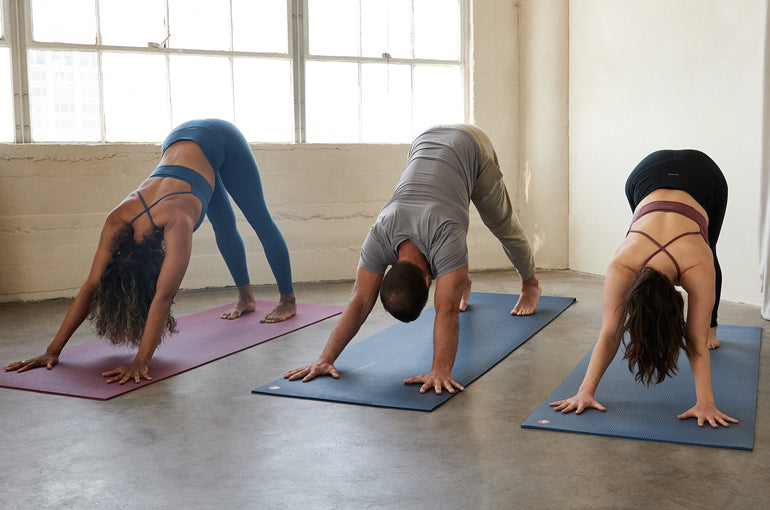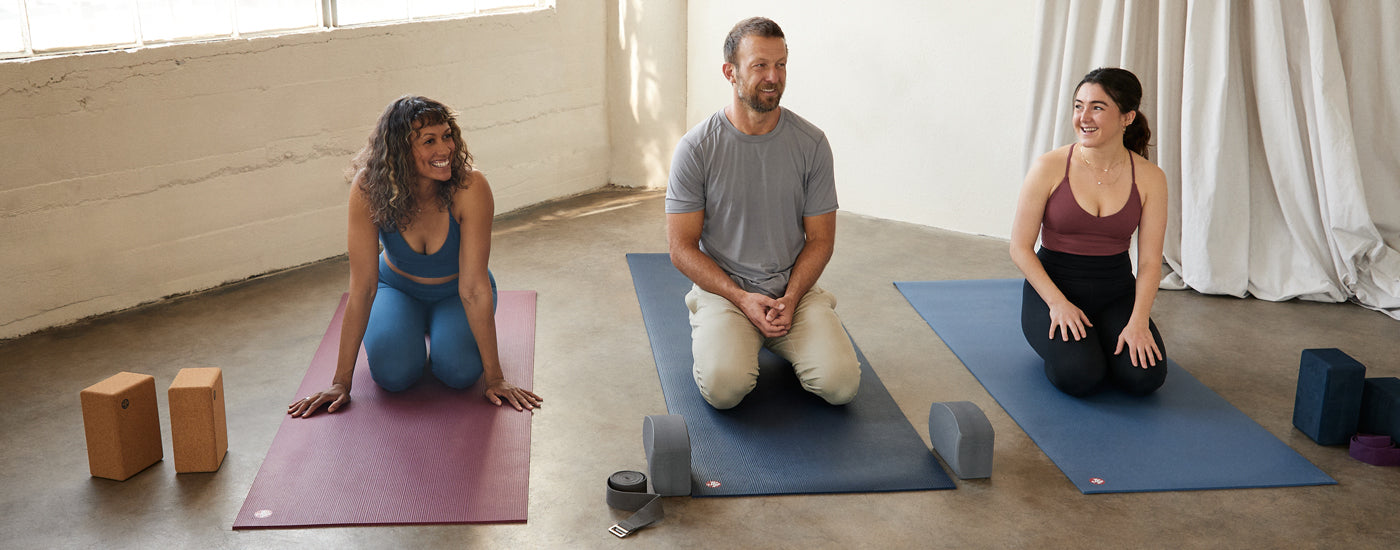
How to find the right style, the right studio and the ideal equipment
You've heard so much about yoga and now you want to try it yourself? Great! In this article, you'll learn everything you need to know as a yoga beginner. We'll explain what yoga is, what benefits you can expect from regular practice, and what you absolutely need to start your individual yoga journey.
1. What is yoga?
"In yoga, people twist themselves on the floor." This idea of yoga is widespread, but it only covers a small part of what yoga really is. Take, for example, a philosophical basis such as Patanjali's Yoga Sutra: It explains what yoga is all about in 196 principles. However, the word "asana", the Sanskrit word for yoga posture, is only found in three of these sentences. Yoga is therefore apparently much more than a physical practice.
But what is yoga then?
There are different translations for the word "yoga", e.g. "unity", "joining" or "path". Thousands of years ago, people in ancient India were searching for religious and spiritual enlightenment - through yoga. They practiced a mixture of physical exercises (asanas), meditation and breathing techniques (pranayama). Over the centuries, different styles with different focuses emerged, but they all had the search for deeper self-knowledge and spiritual enlightenment in common. That is the goal of yoga.
2. What are the benefits of yoga?
Very few practitioners today start practicing yoga because they are looking for enlightenment. Rather, they are striving to improve their mental and physical well-being in everyday life. Yoga can bring these benefits:
• better mobility and physical fitness
• Muscle building
• Less tension and pain
• Better posture
• Better blood circulation and stimulated lymph flow
• Lower blood pressure and thus reduced risk of heart attack
• Better oxygen supply
• Increased attention and awareness
• More serenity, balance, joy of life and the experience of inner peace
• Improved sleep
But you can also start doing yoga for another reason. The motivation for practicing yoga is as individual as the yoga practice itself.
3. Is yoga suitable for everyone?
Basically: Yes. There is no such thing as "too young" or "too old" for yoga, and no such thing as "not fit enough", "not flexible enough" or "not strong enough". If you have certain physical problems, a certain style of yoga may be more suitable than another. That's why it's important that the teacher knows about any problems and physical limitations you may have. You can also speak to a doctor beforehand to make sure that your yoga practice is good for your body.
However, it is important that yoga feels good and right for YOU: Listen to your own gut feeling and respect the limits that your body signals to you. If, for example, a stretch feels too strong, then reduce the intensity of the exercise. The gentler you are to yourself and your body, the more likely you are to enjoy the benefits of yoga.
4. Which yoga style and which asanas are best for beginners?
Many yoga studios indicate directly in their course schedule which classes and styles are suitable for beginners and which ones require a certain amount of experience. But you can basically just go with your gut feeling: Do you want a calm practice that loosens and stretches your body? Then Yin Yoga could be right for you. Would you prefer something more dynamic that will make you sweat? Then start with Vinyasa or Ashtanga.
Depending on your yoga style, you will learn other asanas that are all suitable for you as a beginner. Most yoga classes begin with a sun salutation: This flow is perfect for preparing beginners, but also advanced practitioners, for the respective exercise sequence. Common exercises for beginners include, for example, the downward dog, the cobra or the standing triangle.
For advanced asanas such as the headstand or the crow, you should allow yourself a few weeks or months.
5. Can you teach yourself yoga?
Whether with books or yoga videos on YouTube, many yoga students begin their practice alone at home on their mat. However, you will probably notice that you will quickly reach your limits here: there is no feedback from experienced teachers who can tell you whether you are doing the exercises correctly. If you are interested in yoga, you should seek out a teacher sooner or later.
However, if you want to try out what yoga feels like for you at home with a few videos, you can of course do that.
6. How do I find the right teachers?
In every big city you can find dozens of yoga classes, maybe even hundreds. “How do you find the right one?” you ask yourself. Here too, follow your gut feeling and try out a few different styles and teachers first.
You can use Google to see which yoga studios and teachers are near you. Check out the websites and perhaps their social media profiles: Do you have a good gut feeling when you scroll through them? Then you can usually book a free or discounted trial lesson straight away. Trial lessons are the best opportunity to find out whether you and your dream studio are a good fit.
Once you have found a studio and a teacher that your gut feeling says "yes" to, you have come to the right place. Now your practice can really begin!
7. What can I expect in my first yoga class?
Talk to the person teaching you beforehand and tell them that you are just starting out with your yoga practice. He or she will then explain to you exactly what you can expect during the class. Depending on the yoga style, the yoga class can be structured very differently.
However, the class usually begins with a mindfulness exercise, followed by a simple flow to warm up, e.g. the sun salutation. After that, you practice various asanas under instruction. At the end, there is usually a relaxing final sequence that leads you to the final relaxation, where you lie on your back, close your eyes and reflect.
In some courses, mantras are sung together and breathing exercises and meditations are guided.
8. Which yoga classes are better: in the studio or online?
If you are currently deciding whether to practice online or in a studio, we would recommend going to a studio first. Because only on site can the yoga teachers respond to you and, for example, make posture corrections or support you if you have problems.
Online classes, on the other hand, have the advantage that you can take part from the comfort of your own home. Online classes are a good alternative, especially if you live in a smaller town and don't have a large selection of yoga classes. And of course, online yoga saves you time and effort, because you don't have to travel anywhere and you can even practice in your pajamas if you feel like it. The disadvantage: Even in live classes, yoga teachers cannot respond to your needs as much as they would face-to-face.
However, if you have already completed a few classes, are already familiar with the first asanas and know what to pay attention to when it comes to alignment, online classes are a good alternative to a yoga studio.
9. Is personal yoga training for me?
In addition to attending yoga classes on site or taking part in classes online, you can of course also book a personal yoga training session. The advantages are obvious: you have more flexibility in terms of time and receive individually tailored support. Private teachers can respond much more specifically to your requirements and needs than yoga teachers who have to look after 20 students at the same time. This way, you can feel positive changes much more quickly, better avoid potential injuries and specifically address any pain points that may exist. Private teachers can also take your individual form into account on the day and answer questions that you might not ask in a larger yoga class.
One disadvantage of personal yoga training: you miss the energy of the group. This can be very helpful, especially at the beginning, in getting into your own flow and developing a pleasant yoga practice.
10. When and how often should I practice?
Of course, a certain level of regularity is necessary in yoga if you want to achieve certain goals. But you can also ask yourself the question the other way around: How often do you want to practice yoga? If you feel like it, you can roll out your mat every day and alternate between dynamic and calm yoga styles, for example.
If you work, time is also an issue. How often can you arrange to go to the yoga studio or practice at home after work? You should definitely plan to do it once or twice a week to achieve a positive effect. And once you start to feel the effects, you will naturally want to make time for your yoga.
Do you have any further questions about yoga or do you want to be inspired even further? Take a look at our guide. Here you will find everything you need to know about our products, ideas for yoga practice and lots of inspiration for your mindful lifestyle. We wish you a fulfilling yoga practice!
11. What basic equipment do I need?
The absolute must-haves include, of course, comfortable clothing and a yoga mat that suits your yoga style.
Your yoga clothes
It is best to have at least two different yoga outfits:
• an outfit with long, wide trousers and a comfortable long-sleeved shirt for a quieter practice (e.g. Yin Yoga)
• an outfit with leggings and a tight tank top for more dynamic flows (e.g. Vinyasa)
Your yoga mat
When choosing a yoga mat, it depends very much on which style of yoga you choose.
• If you are still unsure, you should go for an all-rounder. The Ozen4 yoga mat from Ocean to Ocean is a good choice.
• More dynamic flows such as Ashtanga, Vinyasa or Jivamukti are best mastered with a slightly thinner and non-slip mat. They ensure a firm grip, even when the practice is sweaty. For example, use the B MAT Everyday.
• For quieter Yin units or for sequences in which many exercises are performed lying down or kneeling, a mat with good cushioning is suitable, for example the Oeko-Tex certified new wool mat from Ocean to Ocean.
• If you like to travel, a travel mat also makes sense. In contrast to normal yoga mats, it is lighter and can be folded up, for example the Voyager from Jade. This means it fits perfectly in your luggage.
Your yoga accessories
Depending on the yoga style, other aids may be useful:
• Yoga blocks are ideal for beginners because they allow you to perform poses that would otherwise require greater flexibility, making your practice smoother and more balanced.
• A yoga strap will also help you with many asanas: You can use it for various stretching exercises and, for example, slowly work your way towards deeper forward bends.
• For yoga beginners, it is often uncomfortable to sit for long periods of time (to meditate or do breathing exercises). In this case, a meditation cushion is ideal.
• Bolsters are irreplaceable, especially in Yin Yoga, where stretches are held for a long time: they ensure a more comfortable and healthier posture.














